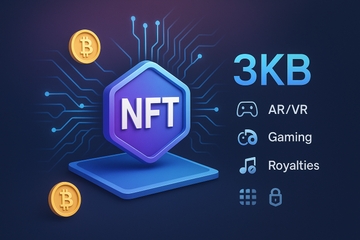Picture this: You’re scrolling through your crypto wallet—maybe Ledger, maybe Trezor—admiring that pixel-art NFT you snagged last year. It’s cool, but you can’t help but wish it could, well, pop out. Maybe do a little twirl, let you peek behind that quirky hat or see the world from a new angle. You know what? The latest buzz in crypto tech is making that a reality, and it’s got a name: BRC-720.
Wait, What’s BRC-720 Anyway?
Let’s not mince words—BRC-720 is a cutting-edge protocol running on Bitcoin’s Ordinals network, designed to shake up the way we think about NFTs. It throws AI into the mix, allowing digital assets to leap from flat 2D images into richly detailed 3D models—all stored and authenticated on the Bitcoin blockchain. In plainer terms, it’s the toolset artists never knew they needed and collectors never realized they wanted, all powered by some seriously clever machine learning magic.
Why Is 3D Such a Game Changer?
There’s something about 3D art that grabs us. Maybe it’s the depth, the realism, or just the plain fun of spinning an object around like a Rubik’s Cube. For NFTs, 3D means your collectibles aren’t stuck on a digital postcard—they turn into objects you can use in games, show off in AR/VR, or even print and stick on your desk. The old 2D stuff starts to look like black-and-white TV: classic, sure, but who wants to live without color television?
Let’s Talk Tech: What’s Under the Hood?
BRC-720 is all about giving digital artists and everyday users tools to create, mint, and even trade 3D NFTs without getting tangled up in technical weeds. Here’s the thing, the magic sauce is in the AI. The protocol uses neural networks—fancy computer brains, if we’re being loose about definitions—to take flat images and predict what a 3D version should look like. It’s a bit like looking at a shadow and imagining what cast it.
What’s even cooler? These 3D files don’t balloon up to giga-sizes. Thanks to some clever encoding, BRC-720 manages to squeeze these models to around 3KB per file. That’s right, smaller than your average meme pic—so you’re not blowing up transaction fees every time you mint or transfer a new collectible.
But What About Quality?
You might be thinking, “Tiny files? Doesn’t that mean pixel soup quality?” Not with BRC-720. The protocol doesn’t just spit out rough shapes; it uses extra layers of quality control—think checking textures, ensuring surfaces are smooth, and that nothing melts into a digital pile of goo. Artists get new dimensions to play with, and collectors still get crisp, faithful versions of their favorite NFTs, just with a fresh perspective.
Where Does AI Come Into Play?
AI isn’t just a gimmick here. You can feed BRC-720 a prompt—yep, just words—and it’ll help create an original 3D asset from scratch. Or, reuse and remix: take an existing NFT, run it through the wringer, and boom, it emerges as a fully-fledged 3D piece, ready for new applications. This means you’re not tied to buying whatever’s served up in static form; you’re part of the creative process, alongside the AI.
Real-World Uses (and a Few Surprises)
- Gaming and Metaverse: Plug your 3D NFT straight into VR spaces or blockchain games. Characters, gear, avatars—the sky’s the limit.
- Art & Collectibles: Artists can launch multi-dimensional series, and collectors can watch their portfolio evolve with the tech.
- Royalties: Artists (and sometimes even collectors) can earn ongoing royalties when their creations are used or sold, all built into the protocol.
- Low-Fee Transactability: Those small file sizes mean cheaper, quicker transactions on the Bitcoin blockchain.
Honestly, it almost feels like BRC-720 is leveling the playing field for solo creators and big teams alike. Even if you’re not a code nerd, you get access to serious 3D chops—no mega software licenses required.
Standing Out from the Crowd: How’s BRC-720 Different?
Sure, Ethereum has its ERC standards, and Solana is fast, but BRC-720 is staking its place as the go-to 3D NFT protocol for Bitcoin. Most other NFT standards focus on 2D media: images, GIFs, short video loops. BRC-720 says, “Why settle?” It gives you interactivity, richer metadata, and a creative AI backbone—not just a static JPEG or MP4.
Compatibility: Will My Ledger or Trezor Wallet Work?
Now, let’s get practical. Security is top of mind for most crypto fans, right? The good news: BRC-720 assets can slot right into existing Bitcoin wallets, including stalwarts like Ledger and Trezor. You may need to make sure your wallet interface supports Ordinals and, ideally, add-ons for 3D previews. But the core compatibility? It’s there, thanks to BRC-720’s strict adherence to Bitcoin standards. So, you’re not stepping into uncharted territory or risking your assets on some untested back-end. That’s a relief, isn’t it?
“But Why Should I Care?”
Let’s be real: Plenty of NFT protocols come and go. What makes BRC-720 genuinely intriguing is how it blends accessibility with future-forward features. If you’re tired of projects that promise the moon but deliver little, here’s something with real utility in gaming, art, and decentralized identity. You get the blend of Bitcoin’s security and AI’s creativity, without the complexity cranked to 11.
To Wrap It All Up…
BRC-720 is much more than just a technical update. It’s a leap toward making NFTs not just rare, but truly alive—interactive, adaptable, and ready for whatever the web throws at us next. Whether you’re a hardcore collector, a curious artist, or just crypto curious, keep an eye on this protocol. The next time someone asks what makes your NFT collection stand out, you’ll have more than a pretty picture to show off—you’ll have the future in 3D, literally at your fingertips.











